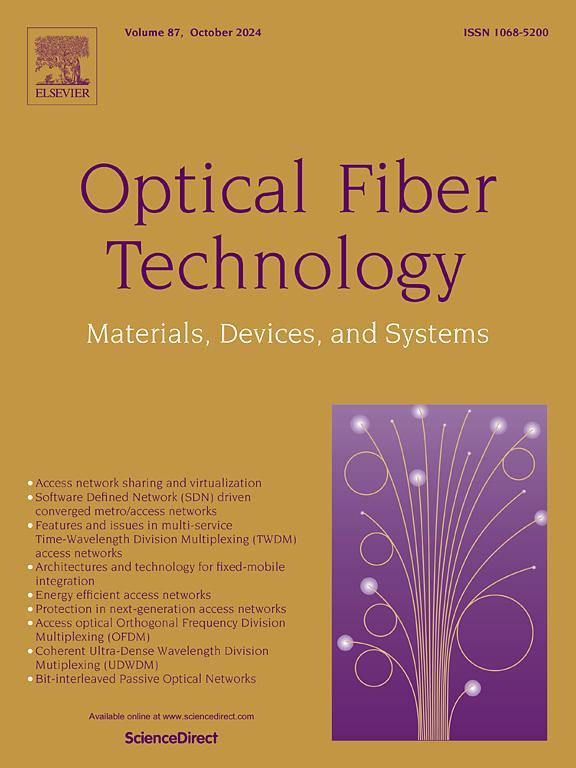Rhodamine 6G fluorescent dye as a saturable absorber for harmonic mode-locked pulses generation in thulium-holmium doped fiber lasers
IF 2.7
3区 计算机科学
Q2 ENGINEERING, ELECTRICAL & ELECTRONIC
引用次数: 0
Abstract
This study investigates the use of Rhodamine 6G as a new saturable absorber (SA) for achieving passive mode-locking in thulium-holmium-doped fiber lasers (THDFLs) operating in the 2 μm wavelength region. An arc-shaped fiber host enables effective interaction of the evanescent field with the Rhodamine 6G layer. The spiral-like surface morphology and nanocrystalline features of the Rhodamine 6G SA were confirmed through field emission scanning electron microscope (FESEM) analysis. With a modulation depth of 15.2 %, the Rhodamine 6G-based SA successfully initiated fundamental mode-locked pulses at a frequency of 14.6 MHz, accompanied by a signal-to-noise ratio (SNR) of 68.7 dB. Stability analysis conducted over an 8-hour operation period showed only minor SNR fluctuations, with a maximum deviation of 1.1 dB, indicating excellent long-term stability. Additionally, by increasing the pump power, the mode-locked laser was able to generate higher-order harmonic mode-locked pulses, achieving up to the 9th harmonic, corresponding to a frequency of 131.6 MHz. This demonstration indicates that Rhodamine 6G is an excellent, low-cost, and efficient organic dye-based SA that is capable of supporting both stable fundamental and harmonic mode-locking in fiber lasers operating in the 2 μm region.
罗丹明6G荧光染料作为掺铥钬光纤激光器谐波锁模脉冲产生的可饱和吸收剂
本研究研究了使用罗丹明6G作为一种新的可饱和吸收剂(SA)来实现工作在2 μm波长区域的掺铥光纤激光器(THDFLs)的被动锁模。弧形光纤主机使倏逝场与罗丹明6G层有效相互作用。通过场发射扫描电镜(FESEM)分析,确定了罗丹明6G SA的螺旋状表面形貌和纳米晶特征。在调制深度为15.2%的情况下,基于罗丹明6g的SA成功启动了频率为14.6 MHz的基频锁模脉冲,信噪比(SNR)为68.7 dB。在8小时的运行周期内进行的稳定性分析显示,信噪比波动较小,最大偏差为1.1 dB,具有良好的长期稳定性。此外,通过增加泵浦功率,锁模激光器能够产生高次谐波锁模脉冲,达到9次谐波,对应频率为131.6 MHz。该演示表明,罗丹明6G是一种优秀的、低成本的、高效的基于有机染料的SA,能够在2 μm区域的光纤激光器中支持稳定的基频和谐波锁模。
本文章由计算机程序翻译,如有差异,请以英文原文为准。
求助全文
约1分钟内获得全文
求助全文
来源期刊

Optical Fiber Technology
工程技术-电信学
CiteScore
4.80
自引率
11.10%
发文量
327
审稿时长
63 days
期刊介绍:
Innovations in optical fiber technology are revolutionizing world communications. Newly developed fiber amplifiers allow for direct transmission of high-speed signals over transcontinental distances without the need for electronic regeneration. Optical fibers find new applications in data processing. The impact of fiber materials, devices, and systems on communications in the coming decades will create an abundance of primary literature and the need for up-to-date reviews.
Optical Fiber Technology: Materials, Devices, and Systems is a new cutting-edge journal designed to fill a need in this rapidly evolving field for speedy publication of regular length papers. Both theoretical and experimental papers on fiber materials, devices, and system performance evaluation and measurements are eligible, with emphasis on practical applications.
 求助内容:
求助内容: 应助结果提醒方式:
应助结果提醒方式:


